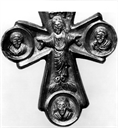Description
Christ stands [or hangs; ambiguous] in the center of this pectoral cross with arms outstretched, revealing nail holes in his hands and feet. The four holy figures in the medallions on the arms of the cross are not labeled, although the cruciform star on the veil of the woman on top identifies her as the Virgin. The bearded figure on the bottom is most likely [almost certainly] John the Baptist, who customarily flanks the Virgin in images of the crucifixion. It does not seem, though, that this actually is a crucifixion, despite the nail holes and the rectangular sign over Christ’s head inscribed IC XC, (abbreviation of IHCYC XPICTOC, i.e. Jesus Christ). Certain significant details suggest that the image is more complicated. For example, while there are nail holes, there are no nails. Instead of tilting in the course of dying, Christ’s head is erect and his eyes open. He wears, not the colobium, the long, sleeveless garment he wears in the earliest crucifixion images from the fifth and sixth centuries, but the tunic and pallium, an ensemble relating to his earlier portrayals as a young teacher or ruler. He is, moreover, youthful and beardless. All of this suggests that the image portrays, not the crucified Christ, nor the living Christ, but the eternal Christ outside of time, triumphant and bearing the marks of his passion.
The method of fabrication was to beat a sheet of gold over a sculpted form, and then to solder it to a flat backing. The date is assigned based on a technical detail. There is a small triangular flap cut into the rear panel, also seen on other late antique jewelry, to allow gases to escape during soldering. Stylistic and iconographic evidence led to the tentative attribution to Egypt.
- S. Zwirn
Bibliography
M. Rosenberg, "Ein goldenes Pektoralkreuz," Pantheon 1 (1928): 151ff.
H. Peirce and R. Tyler, L'art Byzantin, 2 vols. (Paris, 1932) vol. 2, 127, note 2.
J. Werner, "Zwei byzantinische Pektoralkreuze aus Ägypten," Seminarium Kondakovianum 8 (1936): 183ff.
H. Swarzenski, "The Dumbarton Oaks Collection," The Art Bulletin 23 (1941): 77-79.
The Dumbarton Oaks Collection, Harvard University (Washington, D.C., 1955), 78, no. 183, pl. p. 92.
K. Wessel, "Die Entstehung des Crucifixus," Byzantinische Zeitschrift 53 (1960): 95-111, esp. 99-104, pl. 2, fig. 3.
Handbook of the Byzantine Collection (Washington, D.C., 1967), 51, no. 179.
A. Badawy, Coptic Art and Archaeology: the Art of the Christian Egyptians from the Late Antique to the Middle Ages (Cambridge, Mass., 1978), 333.
K. Weitzmann, Age of Spirituality: Late Antique and Early Christian Art, Third to Seventh Century, ed. K. Weitzmann, exhibition catalogue, Metropolitan Museum of Art, November 19, 1977-February 12, 1978, (New York, 1979), 324, no. 301.
H. Demisch, Erhobene Hände: Geschichte einer Gebärde in der bildenden Kunst (Stuttgart, 1984), 295-296, fig. 417.
F. D. Friedman, Beyond the Pharaohs: Egypt and the Copts in the 2nd to 7th Centuries A.D, exhibition catalogue, Rhode Island School of Design. Museum of Art, (Providence, R.I., 1989), 144, no. 52.
K. Veelenturf, Dia brátha: Eschatological Theophanies and Irish High Crosses, Amsterdamse historische reeks. Kleine serie, 33 (Amsterdam, 1997), 129-131, 134, pl. 26.
R. J. Kelly and C. L. Quinn, Stone, Skin, and Silver: A Translation of The Dream of the Rood (Midleton, Co. Cork, Ireland, 1999), 67, 79, pl. 14.
M. C. Ross, S. A. Boyd, and S. R. Zwirn, Jewelry, Enamels, and Art of the Migration Period, Catalogue of the Byzantine and Early Mediaeval Antiquities in the Dumbarton Oaks Collection, 2, 2nd rev. ed. ed. (Washington, D.C., 2005), 21-22, no. 15, pl. 23.
R. Cormack, M. Vasilaki, and B. Mouseio, Byzantium, 330-1453, exhibition catalogue, Royal Academy of Arts, London, October 25, 2008 - March 22, 2009, (London: New York, 2008), 175, 411, no. 129.
Exhibition History
Cambridge, Fogg Art Museum, "A Selection of Ivories, Bronzes, Metalwork and Other Objects from the Dumbarton Oaks Collection," Nov. 15 - Dec. 31, 1945.
New York, Metropolitan Museum of Art, "Age of Spirituality: Late Antique and Early Christian Art, Third to Seventh Century," Nov. 1977 - Feb. 1978.
Providence, Rhode Island School of Design; Baltimore, Walters Art Gallery, "Beyond the Pharaohs: Egypt and the Copts in the 2nd to 7th Centuries A.D.," Feb. 10 - April 16; May 21 - July 16, 1989.



